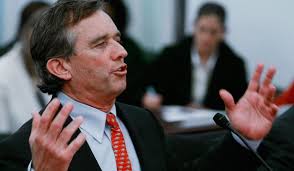Repost from the Bakersfield Californian
[Editor: this is a MUST READ article, a comprehensive and graphic description of first-responder requirements and readiness. Someone needs to interview first responders in each of our Bay Area refinery towns, ask every single question referenced in this article, and lay out similar scenarios for the all-too-imaginable catastrophes that threaten our communities. – RS]
Increased oil train traffic raises potential for safety challenges
By John Cox, Californian staff writer | May 17, 2014
First responders think of the rail yard by Bakersfield High School when they envision the worst-case scenario in Kern County’s drive to become a major destination for Midwestern oil trains. If a derailment there punctures and ignites a string of tank cars, the fireball’s heat will be felt a mile away and flames will be a hundred feet high. Thick acrid black smoke will cover an area from downtown to Valley Plaza mall. Burning oil will flow through storm drains and sewers, possibly shooting flames up through manholes.
Some 3,000 BHS students and staff would have to be evacuated immediately. Depending on how many tank cars ignite, whole neighborhoods may have to be cleared, including patients and employees at 194-bed Mercy Hospital. State and county fire officials say local 911 call centers will be inundated, and overtaxed city and county firefighters, police and emergency medical services will have to call for help from neighboring counties and state agencies.
While the potential for such an accident has sparked urgency around the state and the country, it has attracted little notice locally — despite two ongoing oil car offloading projects that would push Kern from its current average of receiving a single mile-long oil train delivery about once a month, to one every six hours.
One project is Dallas-based Alon USA Energy Inc.’s proposed oil car offloading facility at the company’s Rosedale Highway refinery. The other is being developed near Taft by Plains All American Pipeline LP, based in Houston.
Kern’s two projects, and three others proposed around the state, would greatly reduce California’s thirst for foreign crude. State energy officials say the five projects should increase the amount of crude California gets by rail from less than 1 percent of the state’s supply last year to nearly a quarter by 2016.
But officials who have studied the BHS derailment scenario say more time and money should be invested in coordinated drills and additional equipment to prepare for what could be a uniquely difficult and potentially disastrous oil accident.
Bakersfield High Principal David Reese met late last year with representatives of Alon, which hopes to start bringing mile-long “unit trains” — two per day — through the rail yard near campus.
He said Alon’s people told him about plans for double-lined tank cars and other safety measures “to make me feel better” about the project. But he still worries.
“I told them, ‘You may assure me but I continue to be concerned about the safety of my students and staff with any new (rail) project that comes within the vicinity of the school,'” he said.
Alon declined to comment for this story.
Both projects aim to capitalize on the current price difference between light crude on the global market and Bakken Shale oil found in and around North Dakota. Thanks to the nation’s shale boom, the Midwest’s ability to produce oil has outpaced its capacity to transport it cheaper and more safely by pipeline. The resulting overabundance has depressed prices and prompted more train shipments.
There are no oil pipelines over the Rockies; rail is the next best mode of shipping oil to the West Coast. Kern County is viewed as an ideal place for offloading crude because of its oil infrastructure and experience with energy projects. Two facilities are proposed in Northern California, in Benicia and Pittsburg; [emphasis added] the other would be to the south, in Wilmington.
A local refinery, Kern Oil & Refining Co., has accepted Bakken oil at its East Panama Lane plant since at least 2012. The California Energy Commission says Kern Oil receives one unit train every four to six weeks.
NATIONAL CHANGES
Shipments of Bakken present special safety concerns. The oil has been found to be highly volatile, and the common mode of transporting it — in quick-loading trains of 100 or more cars carrying more than 3 million gallons per shipment — rules out the traditional safety practice of placing an inert car as a buffer between two containing dangerous materials.
The dangers of shipping Bakken crude by unit train have been evident in several fiery derailments over the past year. One in July in Lac-Megantic, Quebec, Canada, killed 47 people and destroyed 30 buildings when a 74-car runaway train jumped the tracks at 63 mph.
The U.S. Department of Transportation said 99.9 percent of U.S. oil rail cars reached their destination without incident last year. Two of its divisions, the Federal Railroad Administration and the Pipeline and Hazardous Materials Safety Administration, have issued emergency orders, safety advisories and special inspections relating to oil car shipments. New rules on tank car standards and operational controls for “high-hazard flammable trains” are in the federal pipeline.
Locally operating companies Union Pacific Railroad Co. and BNSF Railway Co. signed an agreement with the DOT to voluntarily lower train speeds, have more frequent inspections, make new investments in brake technology and conduct additional first-responder training.
Until new federal rules take effect next year, railroads can only urge their customers to use tank cars meeting the higher standards.
“UP does not choose the tank car,” Union Pacific spokesman Aaron Hunt wrote in an email. “We encourage our shippers to retrofit or phase out older cars.”
The San Joaquin Valley Railroad Co., owned by Connecticut-based Genesee & Wyoming Inc., is a short line that carries Kern Oil’s oil shipments and would serve the Plains project but not Alon’s. A spokesman said SJVR is working with the larger railroads to upgrade its line, and the company inspects tracks ahead of every unit train arrival, among other measures designed just for oil shipments.
STATE LEVEL PROPOSALS
Gov. Jerry Brown has proposed a big change in the way California protects against and responds to oil spills.
His 2014-15 budget calls for $6.7 million in new spending on the state’s Oil Spill Prevention and Administration Fund to add 38 inland positions, a 15 percent staffing increase. Currently the agency focuses on ocean shipments, which have been the norm for out-of-state oil deliveries in California.
To help pay for the expansion, Brown wants to expand a 6.5 cent-per-barrel fee to not only marine terminals but all oil headed for California refineries.
“We’ll have a more robust response capability,” said Thomas Cullen, an administrator at the Office of Spill Prevention and Response, which is within the state Department of Fish and Wildlife.
A representative of the oil trade group Western States Petroleum Association criticized the proposal March 19 at a legislative joint hearing in Sacramento. Lobbyist Ed Manning said OSPR lacks inland reach, and that giving such responsibilities to an agency with primarily marine experience “doesn’t really respond to the problem.”
WSPA President Catherine Reheis-Boyd has emphasized the group has not taken a position on Brown’s OSPR proposal.
Also at the state capitol, Assemblyman Roger Dickinson, D-Sacramento, has forwarded legislation requiring railroads to give first responders more information about incoming oil shipments and publicly share spill contingency plans. The bill, AB 380, would also direct state grants toward local contingency planning and training. It is pending before the Senate Environmental Quality Committee.
LOCAL PREPARATIONS
In recent years Kern County has conducted large-scale, multi-agency emergency drills to prepare for an earthquake, disease outbreak and Isabella Dam break. There has not been a single oil spill drill.
Emergency service officials say that’s not as bad as it sounds because disasters share common actions — notification, evacuation, decontamination.
Nevertheless, State Fire and Rescue Chief Kim Zagaris, County Fire Chief Brian Marshall and Kern Emergency Services Manager Georgianna Armstrong support the idea of local oil spill drills involving public safety agencies, hospitals and others.
Kern County is well-versed at handling hazardous materials. Some local officials say an oil accident may actually be less dangerous than the release of toxic chemicals, which also travel through the county on a regular basis.
There have been recent accidents, but all were relatively minor.
Federal records list 18 oil or other hazardous material spills on Kern County railroads in the last 10 years. No one was injured; together the accidents caused $752,000 in property damage.
Most involved chemicals such as sodium hydroxide and hydrochloric acid. Only two resulted in crude oil spills, both in 2013 in the 93305 ZIP code in the city of Bakersfield. Together they spilled a little more than a gallon of oil.
But the risk of spills rises significantly as the volume of oil passing through the county grows.
“The volume is a big deal,” Bakersfield Fire Chief Douglas R. Greener said. “Potentially, if you have a train derail, you could see numerous cars of the same type of material leaking all at once.”
Kern County firefighters are better prepared for an oil spill than many other first responders around the state. They train on an actual oil tanker and have special tools to mend rail car punctures and gashes. The county fire department has several trucks carrying spray foam that suffocates industrial fires.
But Chief Marshall acknowledged a bad rail accident could strain the department’s resources.
He has been speaking with Alon about securing additional firefighting equipment and foam to ensure an appropriate response to any oil train derailment related to the company’s proposed offloading facility.
What comes of those talks is expected to be included in an upcoming environmental review of the project.
“We recognize the need to increase our industrial firefighting program,” Marshall said.
Chief Zagaris said Kern’s proximity to on-call emergency agencies in Tulare, Kings and Los Angeles counties may come in handy under the Bakersfield High spill scenario, which is based on fire officials’ assessments and reports from several similar incidents over the past year.
He and Marshall would not estimate how many people would require evacuation in the event of a disaster near the school, or what specific levels of emergency response might become necessary.
But Zagaris said local public safety officials would almost certainly require outside help to assess injuries, transfer people in need of medical care, secure the city and contain the spill itself.
“I look at it as, you know, depending what it is and where it happens will dictate how quickly” outside resources would have to be pulled in, he said.




 Kelly Johnson
Kelly Johnson
 Kelly Johnson
Kelly Johnson
You must be logged in to post a comment.